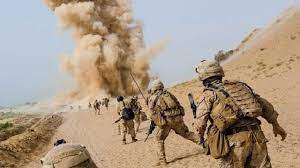An asymmetric war is the one, where there is considerable disparity between the two contending parties, in terms of technology and resources. Some of the most prominent examples of such wars are, the USA–Vietnam War and most recently the US–Afghan war.
The USA (the strong party), initiated a war against Afghanistan (the weak party) by invading it on 7 October 2001 following the 9/11 attacks. Their aim was to keep the war short and decisive (just as in the case of Vietnam War) and they were pretty much successful at toppling the then Taliban regime and assassinating the head of Al-Qaeda, Osama bin Laden (who was also the mastermind of the 9/11 attacks).
However, due to the phenomenon of the “Fog of War” (which postulates that one can determine the start of the war but one cannot predict its end) the achievement of desired goals was impeded. Because afterwards, the resurgence of the Taliban led the USA to gain less and lose more. As a result of this war, the USA had to bear not only the loss of thousands of its troops but, it also had a great impact on its economy (where the USA spent trillions of dollars in Afghanistan) and prestige as well.
In that case, even the increased number of troops or amount of resources remains useless in front of your adversary and the whole international community. Which shows that, despite having conventional superiority over the Taliban, the USA remained unsuccessful in Afghanistan.
Moreover, in such asymmetric wars, it is the overconfidence that the strong states usually have on their capabilities, which often blurs their vision, due to which (the strong) states are unable to figure out the truth of the uncertain nature of war. The more a war is protracted, the more it is difficult to predict its outcome because the objectives of states usually change during the course of that time. In asymmetric wars, protraction of war is a tactic, which the weaker states apply to exhaust their strong adversary and to specifically break their “political will” so that their ability to sustain the war diminishes, because the “political will” of the states is the “driving force” behind waging wars.
They go to war in order to achieve their political objectives. Which shows that in asymmetric wars, the main aim of the weaker party is to break the will of the stronger party, because only in that case they can win the war(s). Another mistake that the stronger parties make while going to a war with a weaker adversary, is that they fail to understand their adversary, which is an important thing to know for any state that is going for a war. Its importance has also been highlighted by Sun Tzu in his book The Art of War, that “if you know the enemy and know yourself, you need not fear the results of a hundred battles”. This is the mistake that the USA has made not once, but twice, specifically in case of the Afghan war. Where, in their overconfidence of having conventional superiority over their adversary i.e. Afghanistan, they failed to study their adversary thoroughly, what were the strengths and weaknesses of their adversary as compared to their own, what kind of terrain and tactics (guerilla tactics) could be used by their weaker adversary, and how they would deal with such an adversary. Due to this, the USA has failed in Afghanistan.
In asymmetric warfare, the main question is to understand that “how” and “why” the external powers withdraw? What are the leading factors that force them to withdraw? The fact that the US has withdrawn its forces twice (first from Vietnam in the 1970s and then from Afghanistan in 2021) shows that it is not just the conventional military superiority that prevails in war rather, it is the political will that sustains the war. The weaker states (such as Afghanistan in this case), being mindful of the disparity with their adversary, know that it is impossible for them to win the war militarily, so their focus is to break the “will” of their adversary to sustain the war.
The aim of the weaker side is to protract the war as much as it can, so that its stronger adversary gets exhausted and its will to fight the war breaks. Because it knows that militarily or technology wise, it is of no match for their stronger adversary (due to high level of asymmetry). And they cannot compete with their adversary through military means.
Another reason why the USA has failed in Afghanistan was because they did not know their enemy. And in order to win a war, one must know who one is going to be fighting with, as for the US troops who were used to pitched battles, fighting war in a mountainous terrain and against the guerilla fighters was difficult. If the USA had made proper calculations, kept the war short and focused only on Afghanistan, then it would have won the war and it would have been successful in achieving their political goals.
So the weaker sides avoid using direct attacks to win war militarily; rather, they focus on indirect attacks (to gain victory through political means). Which is why they avoid confronting their enemy on its own terms. Instead they use the “guerilla tactics” i.e. the hit and run tactics, to confront their enemy.
This tactic helps the weaker states to prolong the war, which not only exhausts their adversary, but puts a high cost on their economy as well, because when the war is prolonged, then the stronger states have to spend more and more resources over time, and sometimes at the expense of their people (Gun vs Butter approach).
Moreover, there is loss of lives (soldiers precisely) and waste of time along with resources. Which would eventually lead to a moment when, even the stronger states could not sustain the war anymore, they would become exhausted and their will to sustain the war would fade away. As a result, they would have to withdraw their forces from that state. Which is what happened with the US, in Afghan war.
All in all, in case of the US–Afghan war, despite having asymmetry between the two parties, the USA has failed. The main reason for the failure was that the USA declared a Global War on Terror. Which means that it was fighting the war on two fronts (Afghanistan in 2001 and then Iraq in 2003), due to which the USA could not focus only on Afghanistan. Had it been only Afghanistan, the results would have been more quick and prominent.
Another reason why the USA has failed in Afghanistan was because they did not know their enemy. And in order to win a war, one must know who one is going to be fighting with, as for the US troops who were used to pitched battles, fighting war in a mountainous terrain and against the guerilla fighters was difficult. If the USA had made proper calculations, kept the war short and focused only on Afghanistan, then it would have won the war and it would have been successful in achieving their political goals.




















